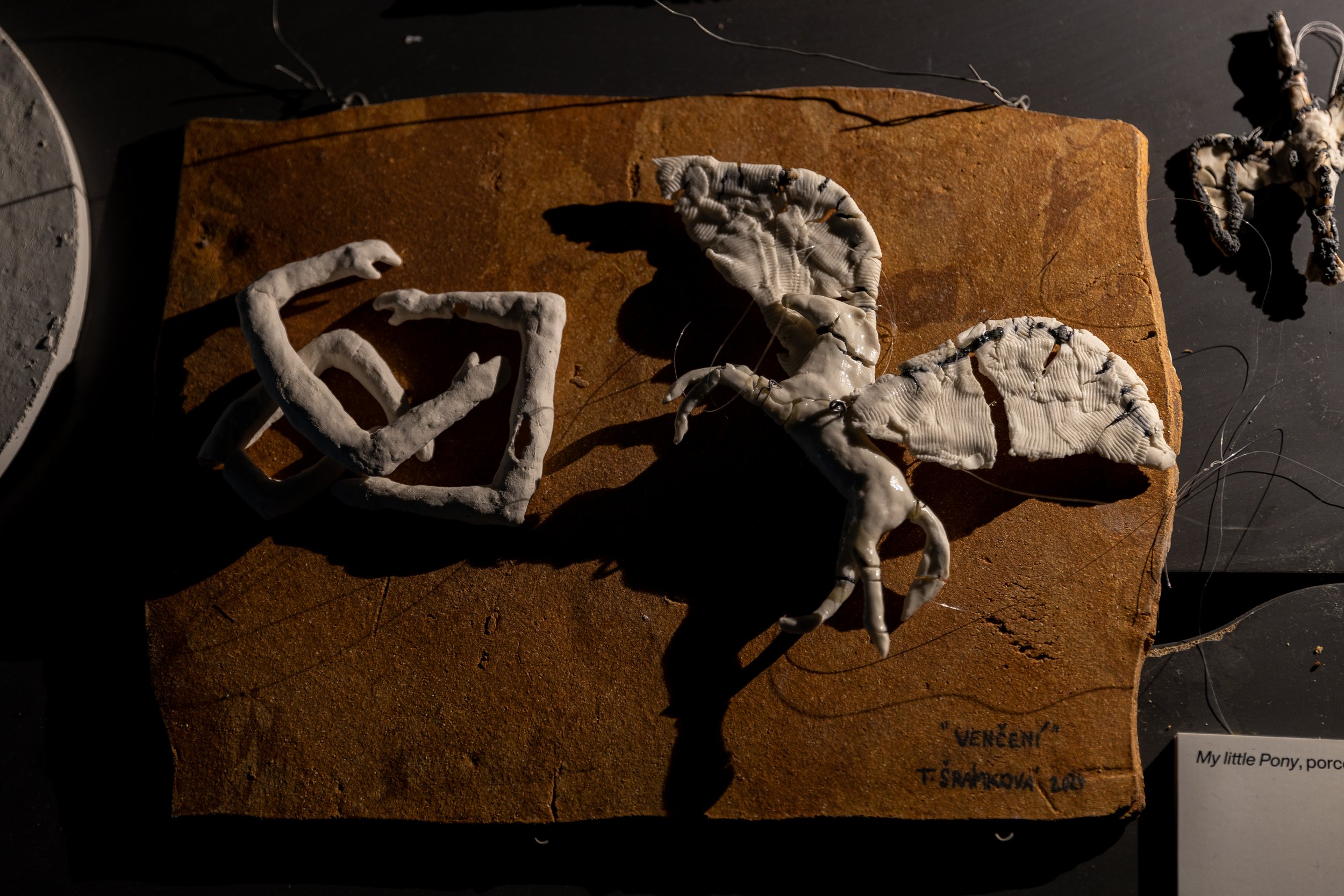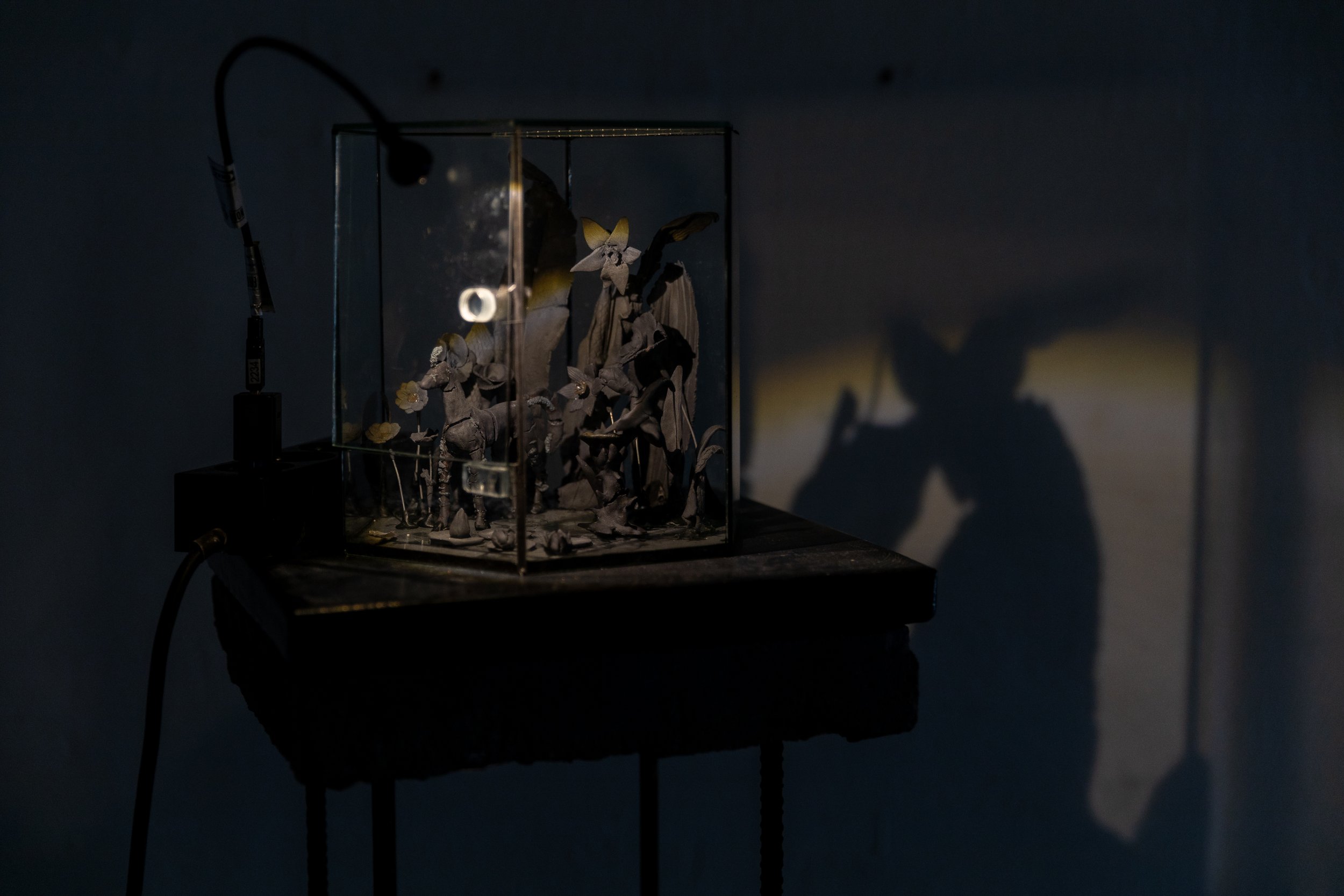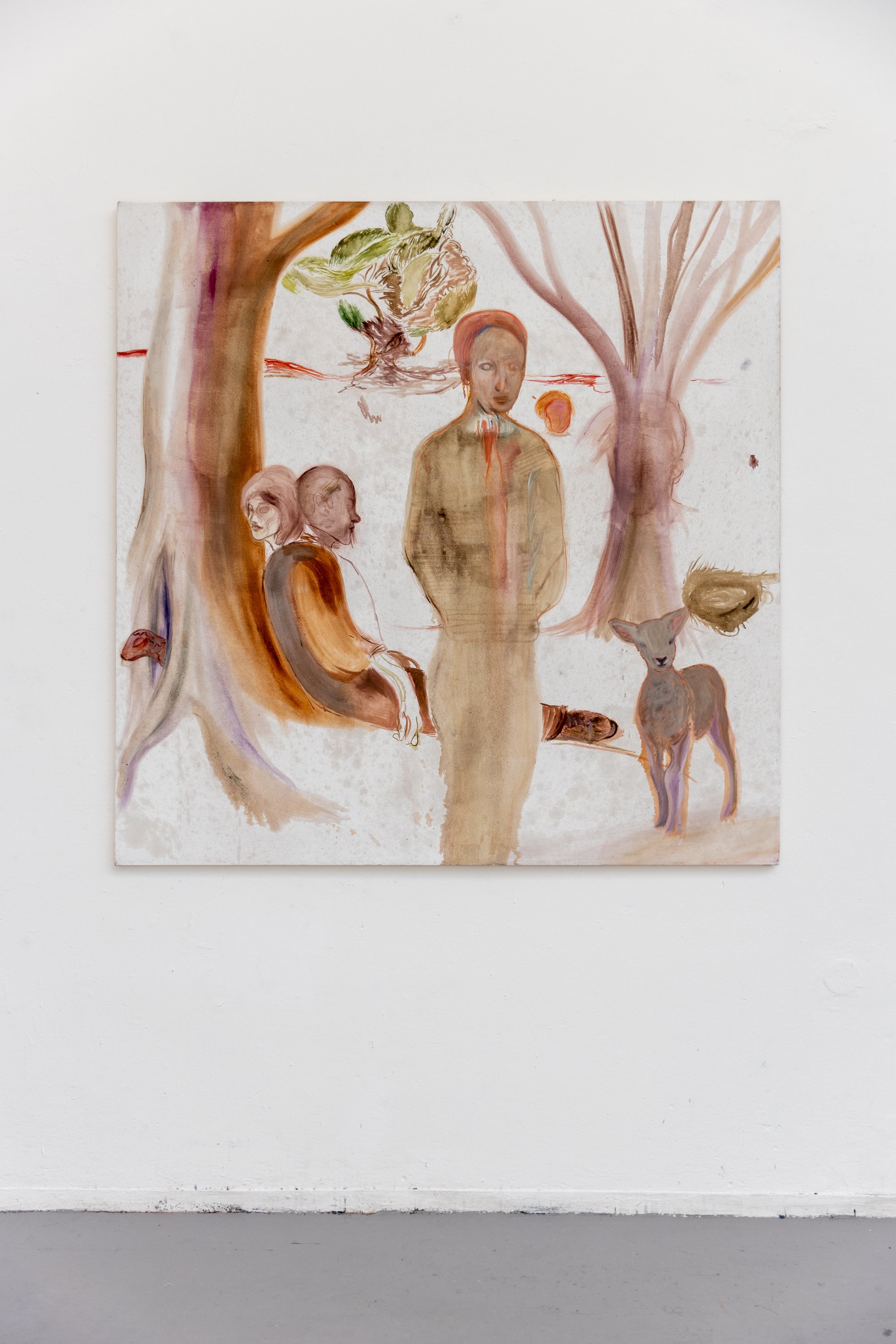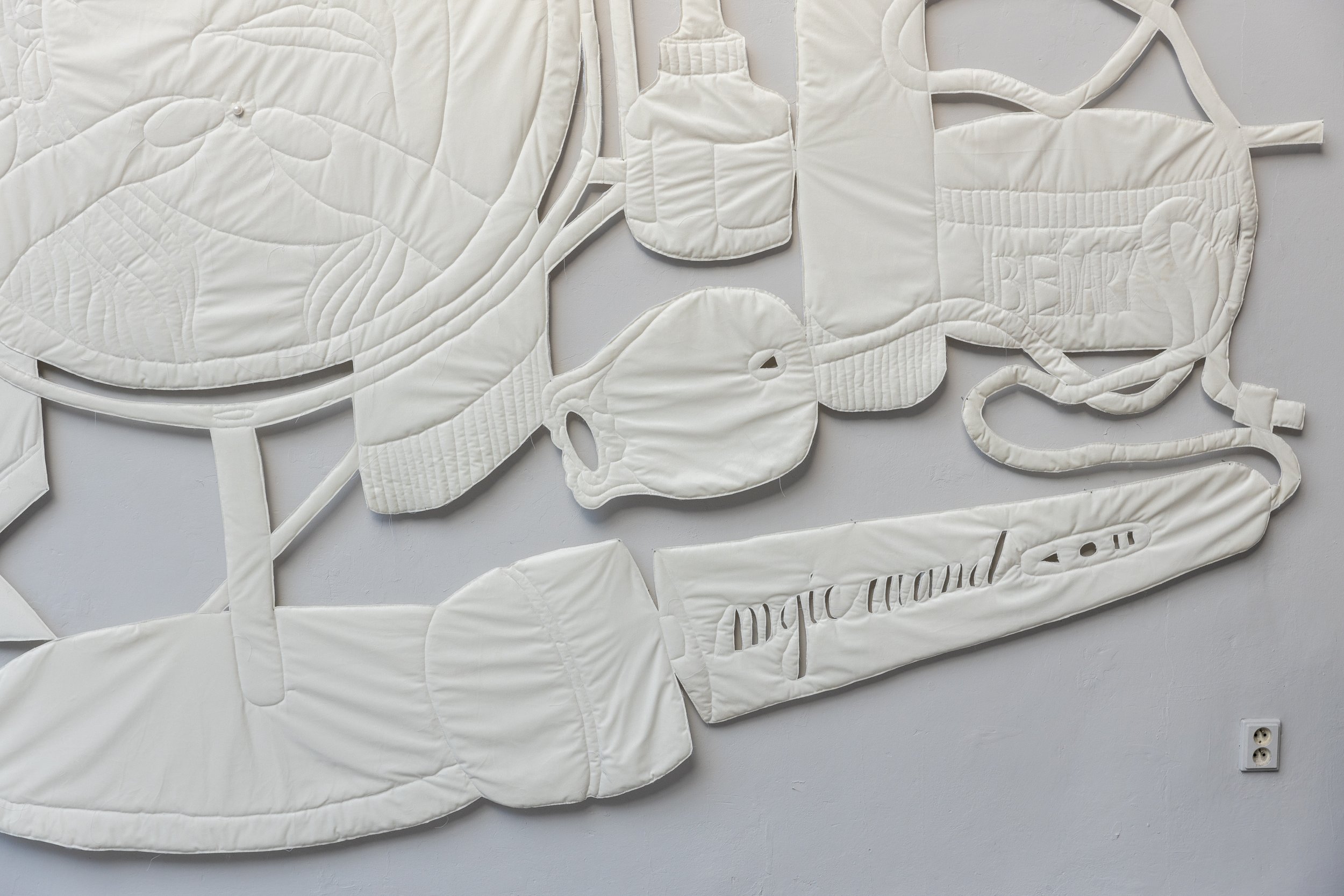AVU DIPLOMA 2024
AVU Diploma Selection 2024: Our Best Picks from the Academy of Fine Arts in Prague
Matěj Čech
MY RENAISSANCE
After a multi-year hiatus during which he focused primarily on music and video, Matěj Čech has returned to painting. His own songs delve into the theme of Czech generational revival, which he interprets as a modern counterpart to Czech national revival. These themes have been expanded to include Czech mythology and local traditions.
Čech's paintings feature representatives of Generation Z, who are connoisseurs of internet memes and embrace the role of visual edgelords—individuals who seek to shock and attract attention with striking and controversial visual elements. The figures in his works are dressed in t-shirts with prints referencing Czech popular culture. This fashion trend combines the extravagance of "high fashion" with everyday elements like soccer jerseys, cleats, or t-shirts emblazoned with images of Richard Genzer. This phenomenon is known in online fashion communities as "post-ironic" fashion.
His painterly style draws inspiration from the Zaalpine Renaissance, characterized by detailed drawing, dynamic interplay between figure and background, and the preservation of Gothic elements. In Čech's works, the use of minimalist backgrounds is evident, allowing for greater focus on the figures themselves and their bold visual features. This approach enhances the contrast between traditional painting styles and modern themes, creating a unique visual experience.
Čech's contemplation of how to authentically link the themes of his music with his visual art has led him to reflect on the visuality of his generation. Through the historical painterly approach to figures, contemporary fashion, post-irony, and the contrast between figures and their environment, he strives to express the complexity of the digital Generation Z.
Tereza Šrámková
CONNECTIONS
Tereza Šrámková's art deftly blends the ancient with the contemporary, crafting delicate porcelain objects that echo the enduring myths and symbols of bygone eras. Her work delves into themes of endurance, regeneration, and the interplay between permanence and decay, employing materials like porcelain to mirror these contrasts.
Šrámková’s early fascination with nature and fantasy evolved into a poignant awareness of humanity’s impact on the environment, inspiring her to envision future scenarios populated by fictional creatures and landscapes. Recently, her focus has shifted to mythic thinking, drawing heavily from the ancient worlds of Egypt and Greece. Her art reinterprets these myths, presenting them through a modern lens.
Her creations often embody ancient concepts of time and eternity, juxtaposing durable and ephemeral materials. This duality is evident in works like her portrayal of Kronos and his children, and her "Underworld Garden," symbolizing themes of death and rebirth.
In her process, Šrámková creates fictional archaeological relics, using discarded materials to symbolize the fusion of consumption and preservation. Her oil paintings on cardboard and porcelain objects reflect a cyclical nature, reinforcing her thematic explorations.
Collaborations with experts such as doc. Jiří Janák enrich her symbolic understanding, shaping the mythological narratives in her work. While her art frequently explores themes of tombs and the afterlife, it focuses on transformation rather than death itself. Šrámková envisions a world where myths thrive independently of modern digital crises, offering a serene escape from contemporary pressures.
Hana Kuklíková
ASTRACHÁNI
Hana Kuklíková’s work, "Astracháni," explores the dynamics of belonging within social groups, drawing from her experiences of feeling on the fringes. The term "Astrachán," coined in the 1930s by journalist Géza Včelička, originally described affluent youth superficially adopting the tramp lifestyle. Kuklíková uses this term to capture the broader experience of seeking acceptance yet remaining an outsider.
Her paintings depict figures within groups marked by subtle signs of their outsider status, such as overly pristine camping gear. This highlights the tension between genuine membership and perceived authenticity. Kuklíková’s scenes from tramp and gardening communities reflect her intimate knowledge of these environments.
In her process, consultations with peers refine her approach, ensuring the paintings resonate with the complexity of her themes. She moves beyond illustration to evoke feelings of inadequacy and disconnection, using detailed close-ups and fragmented compositions.
Kuklíková’s works, featuring untreated canvas and oil applied like dry pastel, emphasize the raw and polished aspects of the outsider’s journey. "Astracháni" captures the balance of belonging and alienation, offering a reflection on the universal struggle to find one’s place within a community, making her work deeply personal and universally relatable.
Liza Libenko
TERRA OBLIVIONIS
During her six-year tenure at the academy, Liza Libenko underwent significant artistic evolution, traversing through abstract collages, figurative art, and finally, a minimalist, expressive style with floral motifs. Her work, "Terra Oblivionis," marks both the culmination of her academic journey and the onset of more serious artistic pursuits.
In 2022, Libenko began experimenting with unconventional materials like asphalt, blending it with industrial paints and embracing chaos and decomposition in her technique. She ignites canvases, mixes incompatible materials, and deliberately damages them, achieving an expressive, chaotic result that embodies life and vitality.
A central symbol in her work is the sunflower, traditionally associated with life and vitality but reimagined as black, diseased, and burned—an allegory for contemporary conflicts and a nod to Georges Bataille's concept of the "rotten sun." This inversion reflects a darker, more complex vision of life and humanity.
Libenko's sunflowers transform from recognizable symbols to abstract, sickly forms, representing a loss of collective identity and an elegy for post-humanity. Her landscapes echo this transformation, drawing inspiration from the poetry of German Expressionism, particularly Georg Trakl, and aiming to be perceived as visual poetry with a decadent touch.
Her work is a testament to her dedication, involving intense, months-long processes to achieve a strong visual impact. Despite the physical labor involved, Libenko's satisfaction lies in the aesthetic resonance of her art, aspiring to create more ambitious projects with adequate support and resources.
Ondřej Klavík
THE ABSENCE OF ABSENCE
Quarries, caves, mineshafts, holes, cavities, and cracks in the surface reveal absence, the presence of something else. Absence is dependent on the presence of the environment that shapes it. When we see a quarry, we don’t necessarily focus on the fact that something is not there, even though it is obvious. A quarry is a cut landscape, an exposed interior, an abyss. It is a matrix of the void.
In his work, Ondřej Klavík depicts the de-materialization of physical volume: mining, digging, removal, relocation. For him, physical substance is more than matter; it can be an idea, information which suddenly finds itself set aside in order to reveal something that is subliminal, beneath the surface. Ideas meet mythology, the re/construction of vanished places, objects, cultures. We find ourselves somewhere between the legible and the abstract, the real and the fictional. The meaning eludes us and disappears; it must be unpuzzled, deciphered. Every time we look, the image changes, the scale disappears and another is revealed. Beyond the original motif, something completely different, something upside-down emerges that eludes identification.
Matouš Hrbek
DO YOU HAVE WHAT YOU SEE BEFORE YOU WITHIN YOU AS WELL?
Matouš Hrbek's graduation work comprises a series of wooden reliefs and easel paintings, deeply influenced by the hours he spends in his studio. This body of work is a self-reflective exploration, beginning as a mental exercise at the table—a metaphor for the gateway to the game of consciousness and self-reflection inherent in the creative process.
Throughout his studies, Hrbek has aimed to express inner existence through expressive painting, often delving into themes associated with childhood, where the act of painting served as therapy. He places great importance on the creative process itself, embracing acts of destruction and accidents that foster a dialogue between drawing and painting. Through this intuitive search, he uncovers stories that he later consciously integrates into his long-term projects. His graduation work continues this exploration, viewing the self through the eyes of another, offering a subdued perspective on the theme of self-identification as an artist.
Hrbek's pursuit of narrative authenticity in painting has led him to find meaning in illustrating ordinary situations that affect him: the sensation of his hands, the presence of a table, or a fly escaping through a window. This current work is more grounded and temporally closer to the present compared to his previous pieces. In this project, Hrbek has focused on interpreting fundamental concepts such as the artist, the artwork, and the material—wood in this case—exploring their interactions and meanings with a fresh perspective.
Jan Štulíř
PLACE AND TIME
"Place and Time" was initially a working title that Jan Štulíř intended to change. Ultimately, he found it fitting. These elements serve as tools to anchor a narrative within specific boundaries. He recalls his admiration for Jan Štursa's sculpture "Wounded," which captures a wartime memory. This piece has always fascinated him, particularly its portrayal of a fateful moment—a concept he finds compelling even in more mundane contexts.
Jan Štulíř addresses a broad range of themes related to human existence, touching on personal identity, social roles, and interpersonal relationships. His starting point is usually the figure, with the choice of subjects being intuitive, sparked by strong emotions. The stories he develops on canvas are never fully told, leaving room for varied interpretations. The series titled "Place and Time" becomes a symbolic space, unbound by specific time and historical anchoring.
Štulíř's graduation work is a continuation of his previous projects, where each piece builds intuitively upon the last. The central theme is the human figure, depicted in relation to its surroundings, its era, and the circumstances it faces. In his paintings, the figure evolves, sometimes merging with natural elements, blurring the line between human and plant forms. This symbolic transformation reflects our intrinsic connection to nature. One of his early works features a giant flower with a human head, reminiscent of shamanic visions or biblical scenes, exploring our relationship with the natural world.
Characters representing various social roles have always appeared in his work. We have seen brides, boxers, clowns, priests, soldiers. In his current work, however, the individual is always placed in specific inner contexts that are crucial for their life.
The creation of this cycle was challenging for Štulíř, marked by a struggle to meet high expectations and a sense of pressure. Early works were repeatedly painted over and eventually discarded as he sought a more honest expression. Over time, he shed unnecessary formal and narrative elements, focusing on essential aspects, which significantly lightened the work. Consultations with his mentors were crucial in this process, helping him navigate feelings of inadequacy and leading to a theme of quiet observation and acceptance.
Tereza Frindová
PATH ALREADY TAKEN
Tereza Frindová's work, "Path Already Taken," explores the self-discovery of the Wayfarer. This character symbolizes courage and independence, challenging the illusion of normalcy and embracing true freedom.
The Wayfarer serves as a guide, linking the narrative. Driven by desires and an uncompromising spirit, the Wayfarer defies conventions and seeks inner transformation. Frindová uses this character to reflect those who reject others' expectations.
Resilient against conformity, the Wayfarer opens new paths. While others conform, the Wayfarer knows normality is an illusion. This journey is marked by freedom and authenticity.
Fear, rejection, and exclusion shape the Wayfarer's journey. The character faces misunderstanding from those who cling to norms, symbolizing the fight for acceptance and individuality.
Frindová challenges the notion of a singular "normal" way to live. The Wayfarer's journey questions these ideas, showing that humanity includes diverse experiences. Themes like home, love, and freedom offer new interpretations.
Frindová bridges past and present, combining memory fragments to create a space where childhood symbols meet new meanings. Her large-format narrative, a mix of drawing and painting, uses symbolism to connect the story.
The long, narrow format captures the Wayfarer's journey and focuses on detail, creating a tapestry-like piece documenting the path. Each segment is like a diary entry, keeping the story mobile and ready to reveal new chapters.
In "Path Already Taken," Tereza Frindová crafts a visual and narrative exploration of self-discovery, challenging norms and celebrating human diversity.
Lucie Rosická
MIRROR, MIRROR ON THE WALL
"Mirror, Mirror on the Wall, Who’s the Fairest of Them All?" The phrase from the tale of Snow White inspired the title of Lucie Rosická’s work. Just like the wicked queen constantly checking her beauty in a magical mirror.
Rosická’s work delves into themes of beauty, observation, the pervasive use of smartphones and social media for validation. These themes have influenced her shift towards self-portraits as a natural way to express her thoughts. Her work is also deeply personal, influenced by her past struggles with eating disorders and her brief career as a model. For Rosická, the naked body in her art is not about eroticism but about communication. She views the nude figure as a blank canvas, free from the constraints that clothing imposes.
During her artistic journey, Rosická initially intended to continue her previous work of quilted paintings stretched on frames. However, several factors, including consultations with her advisors and a residency in Karlovy Vary, led her to explore new techniques. In Karlovy Vary, she experimented with "petrifying" her quilted works in mineral-rich thermal waters, creating unique, stone-like textures that echoed the town's kitschy souvenirs.
Rosická also ventured beyond traditional canvases, creating a massive work that spans an entire studio wall, measuring approximately 9 by 6 meters. This piece documents her life over the past six months, capturing personal and intimate moments. The work, composed of smaller segments, presents a diary-like narrative with monochromatic, often nude figures. It reflects on body image, care, and presentation, and touches on themes like sexuality, sexting, and pregnancy.
Accompanying this large installation are works created during her residency in Karlovy Vary. A notable piece is a small, petrified artwork depicting a face obscured by a phone, symbolizing the eternal gaze of digital validation.
Rosická’s approach combines velvet and batting layers, which she stitches together and enhances with pastels, expired cosmetics, airbrushing, and gel nail polish. Her work bridges the gap between painting and textile art, influenced by Czech textile traditions and contemporary fashion trends.
In "MIRROR, MIRROR ON THE WALL," Lucie Rosická crafts a deeply personal and reflective body of work that challenges societal norms and explores the profound impact of technology on our lives.
Jana Svobodová
TALE OF THE TEAR
Jana Svobodová’s work, "Tale of a Tear," delves into the profound significance of tears, exploring them as both a physiological response and a symbolic expression of emotion. Her work represents a subjective artistic inquiry, aiming to understand the essence of a tear.
Svobodová's journey began with the question: "How can one capture a drop of water in glass?" This led her to infuse the drop with emotion, transforming it into a tear. Her work examines tears as a medium and a universal form of non-verbal communication, expressing a wide range of human emotions.
In her artistic practice, Svobodová captures tears in glass—a material embodying both fragility and resilience. She uses modern technology and traditional craftsmanship to imprint the essence of tears in crystalline forms, exploring their transient nature and permanence. This synthesis allows her to capture the moment of their impact and preserve their essence.
Her installations create an analytical, almost laboratory-like environment dominated by metal and glass. Sculptural elements are arranged to facilitate study and contemplation, transforming tears into tangible objects of expression and introspection. This meticulous approach allows viewers to engage with the emotional depth of tears, encouraging a personal connection to the artwork.
Svobodová’s creative process is deeply influenced by the interplay between memory and emotion. She captures the changing nature of moments and memories, depicting places that evoke a sense of home and belonging. These paintings, born from recollection, blur and rearrange real images, reflecting the fluidity of memory and the passage of time.
"Tale of a Tear" is not just an artistic exploration; it is a profound inquiry into human experience. By examining tears as a medium of communication, Svobodová seeks to foster a deeper understanding of the human condition—our joys, sorrows, and solitude, all encapsulated within a single tear. Her work invites viewers to embark on a journey of observation, recognition, and introspection, revealing the universal language of human emotions.
Karolína Šulcová
HOME
“We live behind our transparent walls that seem woven of gleaming air – we are always visible, always washed in light.” – Yevgeny Zamyatin
For Karolina Šulcová, contemporary life is fraught with the need to blow off steam amidst the endless distractions and worries that adults face daily. Yet, she believes in finding those fleeting moments where one can truly lose oneself. To her, feeling at home means more than just physical space; it involves a deep sense of belonging, an ability to be alone with oneself, to know oneself better, and to have a sanctuary to return to. This act of coming home is as vital as the journeys we undertake, each enriching our lives with a sense of otherness.
Šulcová explores how time away changes us, transforming our perceptions of home. The view upon return is inevitably different, seen through new eyes shaped by experiences. She is fascinated by the uniqueness of moments and how memories evolve over time. Through her art, Šulcová recreates these shifts by painting places that feel like home, working from memory to capture their essence. Just as real places morph in our recollections, her paintings blur and rearrange the true images, reflecting the periods when she is not physically there.
These places hold significance for Šulcová and her ancestors, making the motifs in her work naturally emergent. Her paintings become a meditative exercise in exploring identity, memory, and the concept of home. By capturing the fluid nature of these spaces, Šulcová invites viewers to reflect on their own experiences of home and the transformations that time and distance bring.
Pavel Kytner
NOT MANY TREES AROUND THE HOUSE
Pavel Kytner’s work, “Not Many Trees Around the House” delves deeply into themes of environment, identity, and the human experience. His work is characterized by a profound exploration of the natural world, often reflecting on the absence of trees around homes and the broader implications of this loss.
Kytner’s approach is heavily influenced by his observations of urban and suburban landscapes, where the scarcity of trees signifies a disconnection from nature. This theme runs throughout his work, using a variety of mediums to express his concerns and reflections. His work is a testament to his ability to capture the nuances of these spaces and the emotional resonance they hold.
A significant portion of his work focuses on the interplay between human-made environments and the natural world. Through detailed drawings, paintings, and mixed-media installations, Kytner explores how these environments shape our perceptions and experiences. His pieces often evoke a sense of melancholy, highlighting the stark contrast between the built environment and the natural world.
One notable series within his portfolio is centered around the concept of “absence” and “presence.” Here, Kytner uses the imagery of trees and their absence to comment on environmental degradation and its impact on the human psyche. The use of light and shadow in these works creates a dynamic interplay that draws the viewer into a contemplative state.
Kytner’s artistic journey is also marked by his innovative use of materials. He employs traditional techniques alongside modern digital methods, creating a bridge between past and present artistic practices. This blend of old and new allows him to explore complex themes in a nuanced and layered manner.
Vanda Kováříková
ATMOSPHERE OF ATMOSPHERE
Vanda Kováříková’s work is characterized by her repeated use of landscape motifs and various atmospheric phenomena. She is fascinated by light—how it strikes surfaces, its intensity and colors, and how it saturates the air, transforming the landscape and our perception of it. This fascination extends to the endless cycles of creation and disappearance, capturing the beauty of phenomena that embody both eternity and ephemerality.
The theme of Kováříková’s work is the greenhouse, interpreted figuratively as a protected space where anything can be born and thrive, isolated from its surroundings. This concept evokes the fragility of the creative process, akin to a mental bubble during artistic creation. The greenhouse becomes an imaginative space, a place for ideas to transform and take form, representing an inner landscape limited only by the imagination.
Kováříková’s chosen medium is stone, a material evoking birth, death, and duration, linked to geological time. Stone carries information that encourages contemplation of time, transcending human existence. This is why Kováříková regards stone as sacred. The way stone captures and reflects light makes it better suited to express her sensibilities compared to painting, her original medium.
In her work, Kováříková creates stone reliefs that capture light and shadow, emphasizing the material’s natural properties. Her sculptures depict themes of transformation and growth, paralleling the greenhouse concept where life is nurtured and protected. By using stone, she connects her art to the timeless processes of nature, embodying the cycles of creation and decay.
Kováříková’s artistic process is influenced by the landscapes and atmospheric conditions she observes. She translates these experiences into her stone sculptures, creating pieces that evoke the changing moods of nature. Her work invites viewers to reflect on the transient beauty of the natural world and the eternal cycles that govern it.
Vanda Kováříková crafts a body of work that explores the interplay between light, landscape, and the human experience. Through her use of stone, she captures the ephemeral and eternal qualities of nature, inviting viewers to contemplate the delicate balance between creation and decay. Her work stands as a testament to the enduring power of nature and the limitless possibilities of the imagination.




















































































































































